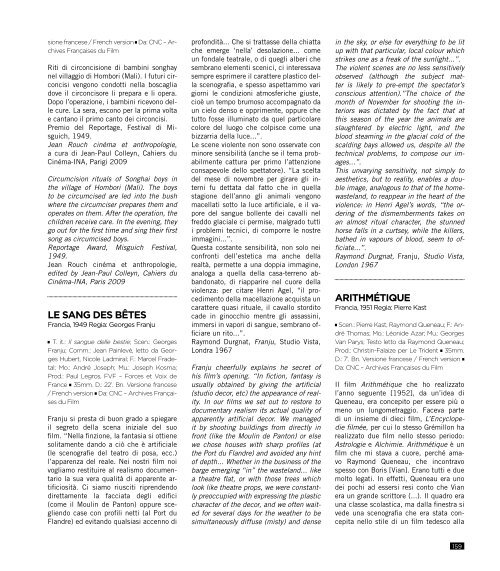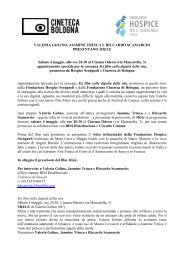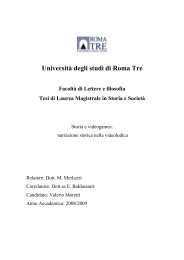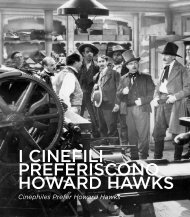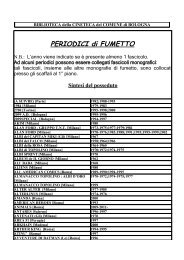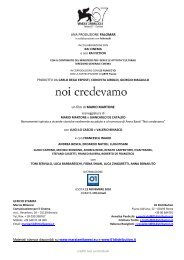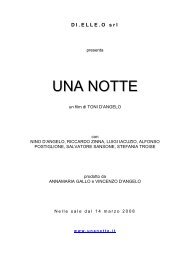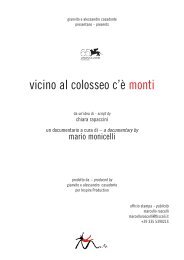Ritrovati & Restaurati sonori.pdf - Cineteca di Bologna
Ritrovati & Restaurati sonori.pdf - Cineteca di Bologna
Ritrovati & Restaurati sonori.pdf - Cineteca di Bologna
Create successful ePaper yourself
Turn your PDF publications into a flip-book with our unique Google optimized e-Paper software.
sione francese / French version █ Da: CNC – Archives<br />
Françaises du Film<br />
Riti <strong>di</strong> circoncisione <strong>di</strong> bambini songhay<br />
nel villaggio <strong>di</strong> Hombori (Mali). I futuri circoncisi<br />
vengono condotti nella boscaglia<br />
dove il circoncisore li prepara e li opera.<br />
Dopo l’operazione, i bambini ricevono delle<br />
cure. La sera, escono per la prima volta<br />
e cantano il primo canto dei circoncisi.<br />
Premio del Reportage, Festival <strong>di</strong> Misguich,<br />
1949.<br />
Jean Rouch cinéma et anthropologie,<br />
a cura <strong>di</strong> Jean-Paul Colleyn, Cahiers du<br />
Cinéma-INA, Parigi 2009<br />
Circumcision rituals of Songhai boys in<br />
the village of Hombori (Mali). The boys<br />
to be circumcised are led into the bush<br />
where the circumciser prepares them and<br />
operates on them. After the operation, the<br />
children receive care. In the evening, they<br />
go out for the first time and sing their first<br />
song as circumcised boys.<br />
Reportage Award, Misguich Festival,<br />
1949.<br />
Jean Rouch cinéma et anthropologie,<br />
e<strong>di</strong>ted by Jean-Paul Colleyn, Cahiers du<br />
Cinéma-INA, Paris 2009<br />
LE SANG DES BÊTES<br />
Francia, 1949 Regia: Georges Franju<br />
█ T. it.: Il sangue delle bestie; Scen.: Georges<br />
Franju; Comm.: Jean Painlevé, letto da Georges<br />
Hubert, Nicole Ladmiral; F.: Marcel Fradetal;<br />
Mo.: André Joseph; Mu.: Joseph Kosma;<br />
Prod.: Paul Legros, FVF – Forces et Voix de<br />
France █ 35mm. D.: 22’. Bn. Versione francese<br />
/ French version █ Da: CNC – Archives Françaises<br />
du Film<br />
Franju si presta <strong>di</strong> buon grado a spiegare<br />
il segreto della scena iniziale del suo<br />
film. “Nella finzione, la fantasia si ottiene<br />
solitamente dando a ciò che è artificiale<br />
(le scenografie del teatro <strong>di</strong> posa, ecc.)<br />
l’apparenza del reale. Nei nostri film noi<br />
vogliamo restituire al realismo documentario<br />
la sua vera qualità <strong>di</strong> apparente artificiosità.<br />
Ci siamo riusciti riprendendo<br />
<strong>di</strong>rettamente la facciata degli e<strong>di</strong>fici<br />
(come il Moulin de Panton) oppure scegliendo<br />
case con profili netti (al Port du<br />
Flandre) ed evitando qualsiasi accenno <strong>di</strong><br />
profon<strong>di</strong>tà... Che si trattasse della chiatta<br />
che emerge ‘nella’ desolazione... come<br />
un fondale teatrale, o <strong>di</strong> quegli alberi che<br />
sembrano elementi scenici, ci interessava<br />
sempre esprimere il carattere plastico della<br />
scenografia, e spesso aspettammo vari<br />
giorni le con<strong>di</strong>zioni atmosferiche giuste,<br />
cioè un tempo brumoso accompagnato da<br />
un cielo denso e opprimente, oppure che<br />
tutto fosse illuminato da quel particolare<br />
colore del luogo che colpisce come una<br />
bizzarria della luce...”.<br />
Le scene violente non sono osservate con<br />
minore sensibilità (anche se il tema probabilmente<br />
cattura per primo l’attenzione<br />
consapevole dello spettatore). “La scelta<br />
del mese <strong>di</strong> novembre per girare gli interni<br />
fu dettata dal fatto che in quella<br />
stagione dell’anno gli animali vengono<br />
macellati sotto la luce artificiale, e il vapore<br />
del sangue bollente dei cavalli nel<br />
freddo glaciale ci permise, malgrado tutti<br />
i problemi tecnici, <strong>di</strong> comporre le nostre<br />
immagini...”.<br />
Questa costante sensibilità, non solo nei<br />
confronti dell’estetica ma anche della<br />
realtà, permette a una doppia immagine,<br />
analoga a quella della casa-terreno abbandonato,<br />
<strong>di</strong> riapparire nel cuore della<br />
violenza: per citare Henri Agel, “il proce<strong>di</strong>mento<br />
della macellazione acquista un<br />
carattere quasi rituale, il cavallo stor<strong>di</strong>to<br />
cade in ginocchio mentre gli assassini,<br />
immersi in vapori <strong>di</strong> sangue, sembrano officiare<br />
un rito...”.<br />
Raymond Durgnat, Franju, Stu<strong>di</strong>o Vista,<br />
Londra 1967<br />
Franju cheerfully explains he secret of<br />
his film’s opening. “In fiction, fantasy is<br />
usually obtained by giving the artificial<br />
(stu<strong>di</strong>o decor, etc) the appearance of reality.<br />
In our films we set out to restore to<br />
documentary realism its actual quality of<br />
apparently artificial decor. We managed<br />
it by shooting buil<strong>di</strong>ngs from <strong>di</strong>rectly in<br />
front (like the Moulin de Panton) or else<br />
we chose houses with sharp profiles (at<br />
the Port du Flandre) and avoided any hint<br />
of depth... Whether in the business of the<br />
barge emerging “in” the wasteland... like<br />
a theatre flat, or with those trees which<br />
look like theatre props, we were constantly<br />
preoccupied with expressing the plastic<br />
character of the decor, and we often waited<br />
for several days for the weather to be<br />
simultaneously <strong>di</strong>ffuse (misty) and dense<br />
in the sky, or else for everything to be lit<br />
up with that particular, local colour which<br />
strikes one as a freak of the sunlight...”.<br />
The violent scenes are no less sensitively<br />
observed (although the subject matter<br />
is likely to pre-empt the spectator’s<br />
conscious attention).”The choice of the<br />
month of November for shooting the interiors<br />
was <strong>di</strong>ctated by the fact that at<br />
this season of the year the animals are<br />
slaughtered by electric light, and the<br />
blood steaming in the glacial cold of the<br />
scal<strong>di</strong>ng bays allowed us, despite all the<br />
technical problems, to compose our images...”.<br />
This unvarying sensitivity, not simply to<br />
aesthetics, but to reality, enables a double<br />
image, analogous to that of the homewasteland,<br />
to reappear in the heart of the<br />
violence: in Henri Agel’s words, “the ordering<br />
of the <strong>di</strong>smemberments takes on<br />
an almost ritual character, the stunned<br />
horse falls in a curtsey, while the killers,<br />
bathed in vapours of blood, seem to officiate...”.<br />
Raymond Durgnat, Franju, Stu<strong>di</strong>o Vista,<br />
London 1967<br />
ARITHMÉTIQUE<br />
Francia, 1951 Regia: Pierre Kast<br />
█ Scen.: Pierre Kast, Raymond Queneau; F.: André<br />
Thomas; Mo.: Léonide Azar; Mu.: Georges<br />
Van Parys; Testo letto da Raymond Queneau;<br />
Prod.: Christin-Falaize per Le Trident █ 35mm.<br />
D.: 7’. Bn. Versione francese / French version █<br />
Da: CNC – Archives Françaises du Film<br />
Il film Arithmétique che ho realizzato<br />
l’anno seguente [1952], da un’idea <strong>di</strong><br />
Queneau, era concepito per essere più o<br />
meno un lungometraggio. Faceva parte<br />
<strong>di</strong> un insieme <strong>di</strong> <strong>di</strong>eci film, L’Encyclope<strong>di</strong>e<br />
filmée, per cui lo stesso Grémillon ha<br />
realizzato due film nello stesso periodo:<br />
Astrologie e Alchimie. Arithmétique è un<br />
film che mi stava a cuore, perché amavo<br />
Raymond Queneau, che incontravo<br />
spesso con Boris [Vian]. Erano tutti e due<br />
molto legati. In effetti, Queneau era uno<br />
dei pochi ad essersi resi conto che Vian<br />
era un grande scrittore (...). Il quadro era<br />
una classe scolastica, ma dalla finestra si<br />
vede una scenografia che era stata concepita<br />
nello stile <strong>di</strong> un film tedesco alla<br />
159


